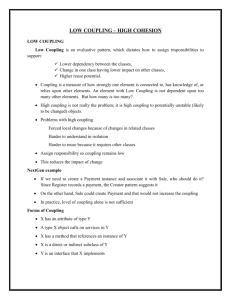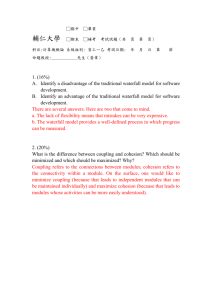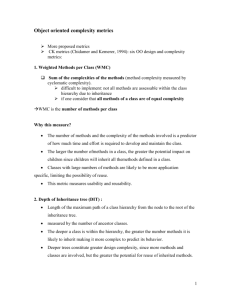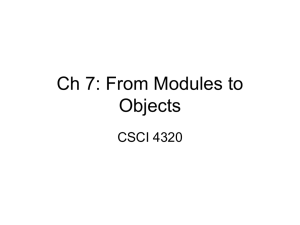archmetric - Clemson University
advertisement
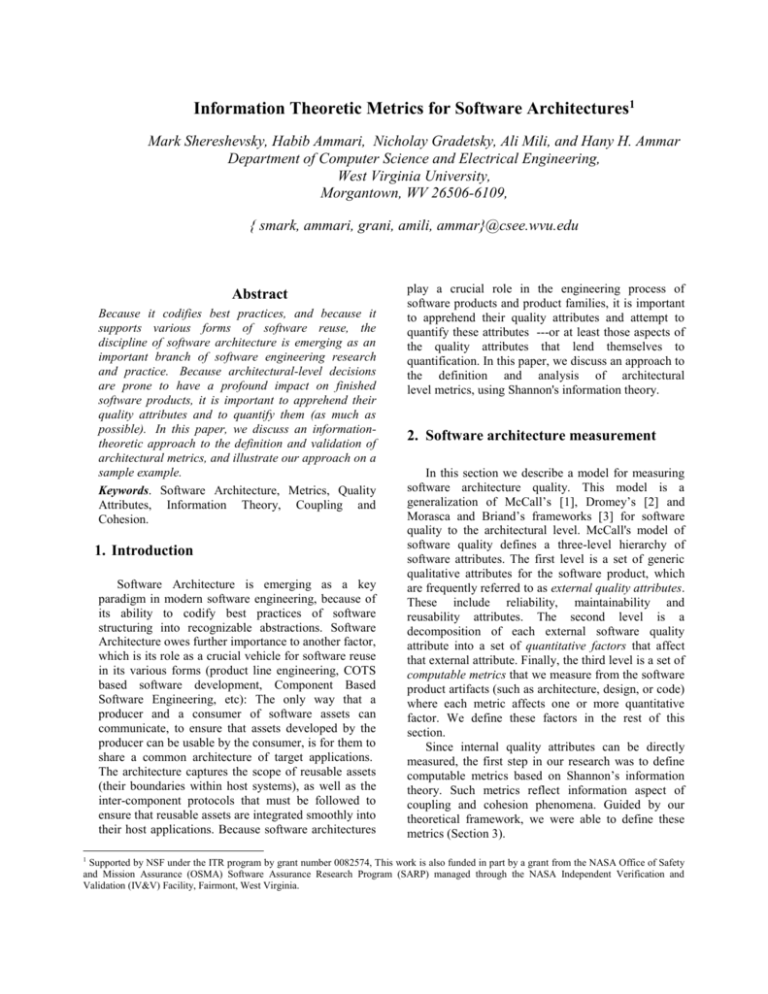
Information Theoretic Metrics for Software Architectures1
Mark Shereshevsky, Habib Ammari, Nicholay Gradetsky, Ali Mili, and Hany H. Ammar
Department of Computer Science and Electrical Engineering,
West Virginia University,
Morgantown, WV 26506-6109,
{ smark, ammari, grani, amili, ammar}@csee.wvu.edu
Abstract
Because it codifies best practices, and because it
supports various forms of software reuse, the
discipline of software architecture is emerging as an
important branch of software engineering research
and practice. Because architectural-level decisions
are prone to have a profound impact on finished
software products, it is important to apprehend their
quality attributes and to quantify them (as much as
possible). In this paper, we discuss an informationtheoretic approach to the definition and validation of
architectural metrics, and illustrate our approach on a
sample example.
Keywords. Software Architecture, Metrics, Quality
Attributes, Information Theory, Coupling and
Cohesion.
1. Introduction
Software Architecture is emerging as a key
paradigm in modern software engineering, because of
its ability to codify best practices of software
structuring into recognizable abstractions. Software
Architecture owes further importance to another factor,
which is its role as a crucial vehicle for software reuse
in its various forms (product line engineering, COTS
based software development, Component Based
Software Engineering, etc): The only way that a
producer and a consumer of software assets can
communicate, to ensure that assets developed by the
producer can be usable by the consumer, is for them to
share a common architecture of target applications.
The architecture captures the scope of reusable assets
(their boundaries within host systems), as well as the
inter-component protocols that must be followed to
ensure that reusable assets are integrated smoothly into
their host applications. Because software architectures
1
play a crucial role in the engineering process of
software products and product families, it is important
to apprehend their quality attributes and attempt to
quantify these attributes ---or at least those aspects of
the quality attributes that lend themselves to
quantification. In this paper, we discuss an approach to
the definition and analysis of architectural
level metrics, using Shannon's information theory.
2. Software architecture measurement
In this section we describe a model for measuring
software architecture quality. This model is a
generalization of McCall’s [1], Dromey’s [2] and
Morasca and Briand’s frameworks [3] for software
quality to the architectural level. McCall's model of
software quality defines a three-level hierarchy of
software attributes. The first level is a set of generic
qualitative attributes for the software product, which
are frequently referred to as external quality attributes.
These include reliability, maintainability and
reusability attributes. The second level is a
decomposition of each external software quality
attribute into a set of quantitative factors that affect
that external attribute. Finally, the third level is a set of
computable metrics that we measure from the software
product artifacts (such as architecture, design, or code)
where each metric affects one or more quantitative
factor. We define these factors in the rest of this
section.
Since internal quality attributes can be directly
measured, the first step in our research was to define
computable metrics based on Shannon’s information
theory. Such metrics reflect information aspect of
coupling and cohesion phenomena. Guided by our
theoretical framework, we were able to define these
metrics (Section 3).
Supported by NSF under the ITR program by grant number 0082574, This work is also funded in part by a grant from the NASA Office of Safety
and Mission Assurance (OSMA) Software Assurance Research Program (SARP) managed through the NASA Independent Verification and
Validation (IV&V) Facility, Fairmont, West Virginia.
2.1 Quantitative factors
The idea of introducing quantitative factors is not
entirely new. Some researchers dealt with fault
propagation [4], error propagation [5] and change
propagation [6]. In this research we study impact that
such factors make not only on the source code or a
particular artifact, but also (and more importantly) to
the overall software architecture. Moreover, we give
formal definitions to each quantitative factor. The
longer term goal of our research is to strive to provide
analytical connection between quantitative factor
measurements and computable metrics, thus
establishing basis for evaluation of internal quality
attributes such as coupling and cohesion early in the
development lifecycle, which in turn provides a
technique for software architect to understand impact
on external quality attributes early.
We have tentatively identified three quantitative
factors, reviewed briefly below.
We use formal definitions to correlate quantitative
factors with the appropriate computable metrics. At
this phase, we are more concerned with defining what
we want to measure, as quantitative factors affecting
the external quality attributes, rather than with how to
measure it. The question of how to measure
(approximate/ estimate/ predict) these quantitative
factors is the subject of the discussion in the next
subsection.
2.1.1.Error propagation. Consider two architectural
components, say A and B communicating through
some sort of connector. Every act of A-to-B
communication consists of passing from A to B a
message selected from certain vocabulary AB (for
example, if the connector is realized in the form of
method invocations, then set AB can be thought of
as the range of values of the “aggregate parameters” of
all methods of B through which A may transmit
information to B). Let SA be the set of states of
module A, and SB be the set of states of module B.
When A transmits to B a message v AB it, in
general, results in B changing its state, thus defining
the state transition mapping F : SB AB SB .
Assuming that the system in question operates
deterministically, F( x, v ) represents the state of
module B after receiving message from A if the state
of B before the transmission occurred was x. For the
sake of convenience, we will sometimes write F( x, v )
as a function of one variable v only, i.e. as Fx( v ),
assuming the pre-transmission state x to be fixed. Now
suppose an error occurs in A and instead of
transmitting v to B it sends v’. The error propagates
into B if the (post-transmission) state of B resulting
from receiving the corrupted message v’ differs from
the state which would result from receiving the correct
message v, i.e. if Fx( v) Fx( v’).
Definition 1: We define the error propagation as the
probability that a random error in the data
transmitted from A to B results in an erroneous state
of B (assuming the pre-transmission state to be
random as well), i.e.
EP(AB) = Prob(Fv(x, v’) Fv(x, v)| x SB ; v, v’
AB , v' v ) .
Error propagation from A to B reflects the likelihood
that an error in component A causes an error in
component B, given that A feeds information to B.
2.1.1 Change propagation
We consider two architectural components, say A and
B, and we let S be the overall system that contains A
and B (possibly along with other components). We
consider the scenario where, following a change
request, we find that we must change A into A'; and we
ponder the question of whether B must be changed
consequently
Definition 2 The change propagation from A to B in S
is defined as the following conditional probability:
CP (A; B) = P(B B' |( A A') ^( S = S') ),
where S' is the system obtained from S by replacing A
by A' and B by B'.
2.1.2 Requirements propagation. We consider two
architectural components, say A and B, and we let S be
the overall system that contains A and B (with possibly
other components). We consider the scenario where,
following a change request, we have determined that
we must change A into A', in order to accommodate a
variation S' of S. We ponder the question whether B
must also be changed as a result of changing A.
Definition 3 The requirements propagation from A to
B in S is the conditional probability
RP (A ; B ; S)= P(B' B | (A' A) ^ (S' S)),
where S' is obtained from S by replacing A and B by
(respectively) A' and B'.
While change propagation (presented in Definition 2)
deals with corrective maintenance, requirements
propagation (presented in definition 3) deals with
adaptive maintenance.
It is easy to see how these three quantitative factors
can be used to assess such qualitative attributes as:
maintainability, reusability, reliability, etc.
3. Information Coupling and Cohesion
Metrics
Our intention in this paper is to present a
construction for coupling / cohesion metrics at a
sufficiently high level of abstraction in order to make it
flexible enough to accommodate, as partial cases, the
metrics specifically designed for the study of various
aspects of information exchange in the architecture
(e.g. data or control metrics), of various methods of
data collection (e.g. static or dynamic) or various
architectural views (such as conceptual, module,
execution or code view see e.g. [7], [8]). In this spirit,
let us consider our architecture A (or, rather, its aspect
which is of interest to us) as a hierarchical multi-level
network of components some of which are connected
by connectors that serve as information transmitting
channels. We model the variety of information packets
transmitted by components to each other via the
connectors by probabilistic ensembles (random
variables), and then use the classical Shannon entropy
[9] to measure information content (amount of
uncertainty) of such ensembles.
Suppose the architecture A in question has the
nested, tree-like hierarchical structure. The lowest
level (level 1) in the hierarchy is occupied by the socalled primitive components, which do not contain any
components, but, instead, have methods (or, using
Rapid terminology, features [10]) through which such
components exchange information with each other. For
any component A in A denote by Sub(A) the set of
sub-components of A. Then the following properties
clearly hold:
Sub(A) = if and only if A is primitive;
for every two components AB we have
Sub(A)Sub(B) = (this implies, in particular that for
every component C there is at most one A such that C
Sub(A);
if BSub(A), then ASub(B).
Notice that the relation defined by ( A B )
(ASub(B)) is a well founded ordering (see e.g.
[MacLane]) on the set N of all components in A. We
can now stratify the set N by setting:
the first level N1 consists of minimal elements of
N with respect to the ordering , i.e. the set of
primitive components ;
the i-th level Ni (i2) is defined recursively by
i
N = { BN | ANi-1 ( A B )}
Thus, all components of the architecture are
stratified into a number of non-overlapping levels: N =
L
N;
i
(ij) (Ni Nj = ). The top level NL
i 1
consists of components which are not subcomponents
of any other component. Our coupling/cohesion
metrics are, mainly, intended to deal with level slices
of architecture A, i.e. the network of components at
the same hierarchical level Ni and connectors between
them.
3.1 Information Coupling
Let A, B Ni be two different level i
components (i 1) which are linked by a connector
which serves as the information transmitting channel
between them. With every such connector we associate
the non-empty set TAB which represents the
vocabulary of all allowable instantaneous information
transmissions that A can pass to B. Note that the set is
chosen based on the aspect of communication in the
system that is to be studied (e. g. data or control
flow). Now, suppose there is a probability distribution
PAB on TAB which encapsulates relative frequencies
of different transmissions TAB. Thus, we have the
probabilistic ensemble (TAB, PAB), (which we call Ato-B information flow ensemble) describing the flow of
relevant information from component A to component
B. Further in the section we will introduce the control
coupling and the data coupling by giving different
interpretations to set TAB. We will also discuss
different approaches to evaluating probability
distribution PAB resulting in the notion of static and
dynamic coupling. Now we define the abstract concept
of A-to-B information coupling without explicitly
specifying the concrete interpretation of the ensemble
(TAB, PAB), but viewing it as an abstract random
variable encapsulating the information contained in
one transmission from A to B. Then we define
coupling between module A and module B as the
Shannon entropy [Shannon] of the ensemble, which
Definition 1. For a connected pair of architectural
components on the same hierarchical level A,BNi Ato-B information coupling is defined as the entropy of
the A-to-B information flow ensemble, i.e. it is, given
by the formula
CPLA(A, B) = H(TAB, PAB) =
P
xTA B
AB
( x ) log PAB ( x ) .
If the pair A,BNi is not connected, we set
CPLA(A, B) = 0.
Notice the asymmetry of the definition: in general
CPLA(A, B) CPLA(B, A). A more detailed analysis of
properties of the information coupling and cohesion is
given in the next section.
3.2 Information Cohesion
The definition is different for primitive (level 1)
components, and for higher (level i > 1) components
through coupling & cohesion of level (i– 1)
components.
3.2.1. Information
Cohesion
of
Primitive
Components. First we define the information cohesion
for primitive components. In order to define the
information cohesion of a primitive component AN1,
we consider the information flow within A. Let TA
represent the vocabulary of all instantaneous
information transmissions that can be passed within A.
(Speaking in terms of modular view, TA represents
information transmissions between various features or
methods of A.) Again, suppose we have a probability
distribution PA on TA which encapsulates relative
frequencies of different transmissions xTA. We then
obtain the internal information flow ensemble of A (TA,
PA), and, define the information cohesion of unit A in
the same spirit as we defined the coupling above.
Definition 2. The information cohesion of primitive
component A is defined as the entropy of the internal
information flow ensemble of A, i.e. by the formula
COHA(A) = H(TA, PA) =
PA ( x ) log PA ( x )
xTA
The terminal components are the ultimate
information transmitting/receiving agents, and the
terminal level connectors are the ultimate information
transmitting channels. This is the reason why the
cohesion for primitive components is defined directly.
On the other hand, for higher level components, is
defined via the coupling between various pairs of its
subcomponents.
3.2.2. Information Cohesion of Higher Level
Components. We now proceed to define the
information cohesion for a non-primitive component
ANi, i 2. We follow the paradigm which views the
cohesion as some kind of intra-modular coupling (cf.
e.g. [11]). The terminal components are the ultimate
information transmitting/receiving agents, and the
terminal level connectors are the ultimate information
transmitting channels. This is the reason why the
cohesion for primitive components is defined directly.
On the other hand, when dealing with a higher level
component, one may not have direct access to the
information exchanging agents (which may lie several
levels deeper). Thus, the information cohesion is
defined via coupling between various pairs of its
subcomponents. Let QAB(), , Sub(A), be
the conditional probability that the information passes
exactly through -to- sub-connector, given it is
known that some subcomponent of A sends
information to another subcomponent of A, i.e. the
probability distribution {QAB()| ,Sub(A),
} captures the relative likelihood of activation of
different connectors inside A once it is known that a
communication occurs within A. This distribution
must, of course, must satisfy the standard probability
axioms:
1 QAB() 0 for all , Sub(A),
and
Q AB ( , ) = 1.
, Sub( B )
Notice, that the number of pairs (, Sub(A),
and, hence, the number of probability values
needed to describe the distribution equals s2 – s, where
s = |Sub(A)|. We are now in the position to define the
A-to-B information cohesion.
Definition 3. For a level i component ANi (i 2) the
information cohesion of A is defined as the weighted
sum (mean) of pair-wise couplings between subcomponents of A:
CPLA (A, B) =
, Sub( A ),
Q A B ( , ) CPLA ( , ) .
Thus we define the information cohesion of a
composite component A as a probabilistically weighted
sum (the mean) of coupling values between pairs of its
subcomponents.
By giving a particular interpretation to the
transmission vocabulary TAB (or TA) and the
probability distribution PAB (or PA) on it, the general
concept of information coupling/cohesion can be
meaningfully applied to various aspects of information
flow in the architecture. Next, we apply the
construction above to define the control and data
information coupling & cohesion metrics.
3.3 Control Coupling and Cohesion
Let us first consider the control flow in A. Here our
Interpretation of the general approach presented above
will be based on rather concrete and implementationspecific model suggested by the Rapid AMD which
has been used in our experimental study (Section 5).
The model, in fact, embodies a more universal idea of
using interface-based communication to ensure
encapsulation of private information within
components. In the framework of this model any nonprimitive component A N \ N1 has a special
primitive subcomponent IA Sub(A)N1, called
interface subcomponent, which is used by nonterminal components for external communication with
each other. Let Fprov(IA) be the set of all provided
features (methods) of the interface component IA. Let
A, B N \ N1 be any pair of non-primitive
components. To define the control information
coupling which would describe the control flow aspect
of the A-to-B communication, we interpret the A-to-B
control
information flow ensemble as follows. Let T A B =
Fprov(IB), i.e. the control flow ensemble, whose
information content we intend to measure, is defined
on the set of provided features Fprov(IB) of the interface
of the receiver component B. This approach is
motivated by the idea that module A passes control
information to B by “choosing” to request one of its
provided features.
The probability distribution
PAcontrol
on N(B) is defined so that PAB(f) reflects the
B
relative likelihood for the particular feature fFprov(IA)
to be requested by A. For a pair of primitive nodes A,
control
B N1 we set T A B
control
= Fprov(B) , i.e. identify T A B
with the set of provided features of the receiver
control
component itself; the probability distribution PA B
control
on T A B
= Fprov(B) is defined in the same natural
manner as for the non-primitive components above.
Now we simply apply the abstract Definition 1 to
control
the control information flow ensemble ( T A B ,
PAcontrol
B ), in order to define the control information
coupling.
Definition 4. For two connected nodes A, B at the
same hierarchical level the A-to-B control
information coupling is defined as the entropy of the
A-to-B control information flow ensemble:
control
control
CPLcontrol(A, B) = H( T A B , PA B ).
If there is no connector from A to
CPLcontrol(A, B) = 0.
B , we set
The control information cohesion for a nonprimitive component is defined by straightforward
rewriting of Definition 3. The definition of control
information cohesion for a primitive component AN1
is obtained by applying Definition 2 to the ensemble
control
( TA
,
PAcontrol ), where TA = Fprov(A), and the
control
probability distribution PA
represents relative
likelihood for various particular feature fFprov(A) of
A to be requested by other features in A. Thus, the
control
control
entropy of the ensemble ( TA
, PA
), embodies
the control information flowing between various
features of A.
3.4 Data Coupling and Cohesion
Now let us look at the data exchange between
modules of A and define the corresponding
information coupling and cohesion metrics which
reflect this aspect of information flow in the
architecture. Let A, B Ni be a pair of non-primitive
components at hierarchical level i 2. For every
feature fFprov(IB) let VAB (f) be the entire range of
possible values for the vector of data (parameters) that
can be transmitted from A to B when A calls B and
requests feature f. Similarly, for gFprov(IA) let V AB
(g) be the entire range of possible values for the vector
of data (parameters) that can be transmitted from A to
B when B calls A and requests feature g. One should
keep in mind that data can be transmitted from A to B
both when A calls B and when B calls A. At the code
level, V AB (f) for fFprov(IB) is the Cartesian product
of legal value ranges for all parameters (variables)
supplied by A when it calls f. Then we construct our Ato-B data flow ensemble AB as the union of the
ranges V AB (f) for all provided features f of A and B,
i.e.
T Adata
B =
V AB(f) . Thus defined, the
f F prov( A) F prov( B )
ensemble AB incorporates all possible instances
(“generalized values”) of packets of data that the
module B is capable of receiving from A. Then we
data
data
introduce on T A B the probability distribution PA B
that reflects the relative likelihood for different data
data
packets (values) T A B to actually be transmitted in
the system. To avoid unnecessary repetitiveness we do
not discuss the (quite obvious) adjustments of the
above definitions that need to be made in the case
when A and B are primitive components.
By applying the Definition 3 to the A-to-B data
information flow ensemble ( T
data
A B ,
data
A B
P
), we arrive
at the definition of the data information coupling.
Definition 5. For two connected nodes A, B at the
same hierarchical level the A-to-B data information
coupling is defined as the entropy of the A-to-B data
information flow ensemble:
data
data
CPLdata(A, B) = H( T A B , PA B ).
If there is no connector from A to B , we set
CPLdata(A, B) = 0.
The data information cohesion for a non-primitive
component is defined by straightforward rewriting of
Definition 3. The definition of control information
cohesion for a primitive component AN1 is obtained
data
by applying Definition 2 to the ensemble ( TA
data
),
A
P
data
and
A
,
data
are
A
where T
defined in an
P
obvious way to reflect the information content of the
data flow between various features of A (see end of
Paragraph 3.4), so we leave the details to the reader.
4.
Related work
Software architecture is evolving as a beneficiary
discipline in the development of software applications
in general [12], [13] and for product lines in specific
[14]. This has resulted in a significant amount of
research to model architectures using Architecture
Description Languages (ADLs) such as Rapide [15],
and an increasing demand for evaluating the quality of
software architectures. Architecture analysis and
evaluation techniques are mostly qualitative and have
special focus on application architecture with little
emphasis on reusability issues in product line
reference architectures. We also used [16] and [17] as
a reference of quality measures. Interesting approach
for characterization of quality attribute is presented in
[18].
Software Architecture Analysis Method (SAAM).
SAAM [19] is an evaluation method for software
architectures that is used to assist in evaluating
competing architectures for a software system. SAAM
is a method for coarse-grained evaluation of software
architectures with respect to specific desired system
quality attributes. These specific attributes are derived
from usage scenarios [20]. For each scenario, a
ranking of the architecture being evaluated is
developed. The ranking could be as simple as
evaluating whether the candidate architecture supports
the scenario or not. An obvious defect in this approach
is the lack of formalization, optimization, and
quantitative measures.
Architecture Trade-Offs Analysis Method
(ATAM). The ATAM research [21], [22] focuses on
the development of techniques and models to assess
and evaluate architectures. Architectures possess
attributes such as performance, modifiability,
maintainability, security, etc. The emerging ATAM
method is based upon a set of quality attributes. Some
of these attributes are analytical (performance and
availability) and others are qualitative, based upon
formal inspections (modifiability, safety, and
security). The ATAM is aimed at establishing proven
techniques for predicting the impact of software
architecture decisions on selected product quality
attributes such as performance, robustness, and
modifiability. In ATAM, each component is assigned
a quality measure that is a combination of the quality
attributes gathered from answers to the attributespecific questions. The ATAM approach helps in
discovering risks at early development and design
stages, and in defining sensitivity and trade-off points
(points where one change could affect multiple
attributes) in a candidate architecture. Although the
technique formalizes the steps of evaluating an
architecture, it is still mostly qualitative.
In summary, we concur with Bergery [23] to the
conclusion that current methods of architectural
analysis are primarily qualitative; whence we need to
focus more attention on quantitative approaches.
5. Summary and Prospects
In this paper, we have presented a hierarchy of
definitions for cohesion and coupling of components
in software architecture. All our metrics are defined
as (or based on) entropies of some probabilistic
ensembles (random variables). Those are, in turn,
defined to reflect static and dynamic properties of the
architecture at hand, with respect to data exchange and
control exchange between architectural components.
Because this work is in its infancy, we cannot
offer any empirical validation of the metrics that we
propose. However, we feel that the rationale of these
definitions and the inherent symmetries that we have
attempted to achieve among them provides some
confidence in their adequacy. Nevertheless, we do
plan for their empirical validation in our future
research.
The empirical validation that we envision will
establish correlations between the proposed
(computable) metrics and the quantitative factors
discussed in Section 2. Longer-term goals include the
analysis of the correlation between quantitative factors
and qualitative attributes; and the automation of the
derivation of computable metrics by means of
syntactic and semantic analyzers that process
architectural descriptions written in an ADL
augmented with probabilistic annotations.
6. References
[14]. P. Clements and J. de la Puente. Analysis of Software
Architectures. Second International ESPRIT ARES
Workshop on Development and Evaluation of Software
Architectures for Product Families, Las Palmas de Gran
Canaria, Spain, February 1998, LNCS 1429, pp140-143.
[15]. The Rapide Architecture Description Language.
Stanford University, http://pavg.stanford.edu/rapide/.
[1]. J. McCall, P. Richards, and G. Walters. Factors in
Software Quality. RADC TR-77-369 1977. Vols I, II, III US
Rome Air Development Center Reports NTIS AD/A-049
014,015,055, 1977.
[2]. R. Dromey. A Model for Software Product Quality.
IEEE Transactions on Software Engineering 21:146-62, Feb
1995.
[3]. S. Morasca and L. C. Briand. Towards a Theoretical
Framework for Measuring Software Attributes. In
Proceedings of the 4th International Software Metrics
Conference, pp119-126, Albuquerque, New Mexico,
November 1997.
[4]. Barbacci, Mario R, Klein Mark H., Weinstock Charles
B. “Principles for Evaluating the Quality Attributes of a
Software Architecture”. CMU Technical Report CMU/SEI96-TR-036, ESC-TR-96-136, May 1997
[5]. J. Voas; F. Charron, L. Beltracchi. Error propagation
analysis studies in a Nuclear Research Code. 1998.
[6]. R. Arnold and S. Bohner. Software Change Impact
Analysis. IEEE Computer Society Press. ISBN 0-81867384-2, 1996.
[7]. P. Kruchen. The 4+1 View Model of an Architecture.
IEEE Software, November, 1995 pp. 42-50.
[8]. Hofmeister C., Nord R., Soni D. Applied Software
Architecture. Addison-Wesley, 1999
[9]. C. Shannon. A Mathematical Theory
Communication. Bell Syst. Tech. J., Vol. 27, 1948.
[10].
The
Stanford
http://pavg.stanford.edu/Rapide/
[13]. M. Shaw and D. Garlan. Software Architecture:
Perspectives on an Emerging Discipline. Prentice Hall,
Upper Sadle River, NJ 1996.
Rapide
of
Project,
[11] E. B. Allen and T. M. Khoshgoftaar. Measuring
Coupling and Cohesion: An Information-theory Approach.
In Proceedings of the Sixth International Software Metrics
Symposium, pp119-127, Boca Raton, Florida USA, Nov.
1999.
[12]. L. Bass, P. Clements, and R. Kazman. Software
Architecture in Practice. Addison Wesley Longman, 1998.
[16]. R. Dromey. A Model for Software Product Quality.
IEEE Transactions on Software Engineering 21:146-62, Feb
1995.
[17]. J. Duenas, W. del Oliveira, and J. de la Puente. A
Software Architecture Evaluation Model. In Proceedings of
the Second International ESPRIT ARES Workshop on
Development and Evaluation of Software Architectures for
Product Families, LNCS 1429, pp148-157, Las Palmas de
Gran Canaria, Spain, February 1998.
[18]. Barbacci M., Ellison R., Weinstock C., Wood W.
Quality Attribute Workshop Participants Handbook. CMU
Special Report. CMU/SEI-2000-SR-001.
[19]. R. Kazman, L. Bass, G. Abowd, and M. Webb.
SAAM: A Method for Analyzing the Properties Software
Architectures. In Proceedings of the International
Conference on Software Engineering, ICSE'94. May 1994,
pp81-90.
[20]. R. Kazman, G. Abowd, L. Bass, and P. Clements.
Scenario-Based Analysis of Software Architecture. IEEE
Software, Vol 13:47-55, November 1996.
[21]. R. Kazman, M. Klein, M. Barbacci, H. Lipson, T.
Longstaff, and S. Carriere. The Architecture Tradeoff
Analysis Method. In Proceedings of the 4th International
Conference on Engineering of Complex Computer Systems,
ICECCS'98. Monterey, CA, August 1998.
[22]. R. Kazman, M. Klein, P. Clements. ATAM: Method
for Architecture Evaluation. CMU Technical Report
CMU/SEI-2000-TR-004, August 2000.
[23]. J. Bergery, et. al. DoD Product Line Practice
Workshop Report. Technical Report CMU/SEI-98-TR-007,
May 1998.
